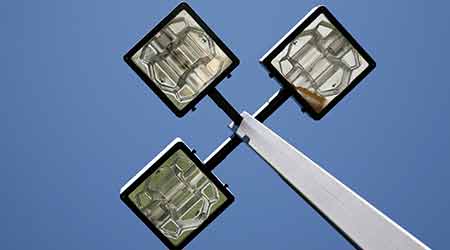Exterior Lighting: LED Advances
As LED technology has changed, a properly planned retrofit of exterior lighting systems can improve energy efficiency and protect occupants and visitors.
From sidewalks and parking lots to facades and signage, an array of exterior areas of institutional and commercial facilities require lighting. Even though exterior lighting systems often go overlooked when conversations turn to lighting upgrades, these projects can offer benefits such as energy-efficiency gains and enhanced appearance, security, and safety — if maintenance and engineering managers plan and perform them properly.
By understanding advances in exterior lighting technology, including LEDs and lighting control technologies, managers will better able to match new-generation lighting products to their facilities’ exterior lighting needs.
Technology talk
Technology advances have affected nearly every component of lighting systems in institutional and commercial facilities.
Advances in network-controlled LED street lights, area lights, post-tops, landscape lighting, signage lighting, and wall packs offer managers significant cost and functional improvement opportunities. By incorporating dimmable LEDs as a part of the network control system, managers can strategically placed motion sensors in key areas to detect activity, which can lower energy use by 50 percent and increase lighting to a safe level.
LED lamps with solar and battery capability provide an efficient combination for landscape, wall packs, and post-top lights. The solar panel located in the fixture housing charges the battery during daylight hours and switches to the battery for light-time illumination at a fraction of the energy cost.
Luminaire designs offer distinct lighting advantages while keeping costs lower. New technology, such as reflector designs like automobile headlight and taillight lenses, increase the range of light.
Induction lamps, which are energized by an external electromagnetic field and do not use electrodes and filaments that burn out, can last up to 100,000 hours and seldom need replacement or maintenance. These benefits makes them, like LEDs, a good choice for hard-to-reach exterior spaces. Their lumens per watt is 90 compared to 120 for LEDs. These lamps are compatible with many types of lighting controls,but might require special adaptations for dimming. They also have excellent temperature range, down to -40 degrees without the flickering that often occurs with fluorescents.
Lighting controls’ increased flexibility and functionality offer managers improved energy efficiency. The controls requirements of energy standards aim to maximize the energy efficiency of lighting systems while also ensuring building occupants are comfortable and safe.
Managers can employ many control strategies, including occupancy control, scheduling, tuning, and automated demand response. Regardless of the strategy, many lighting control systems are certified by authorities having jurisdiction, such as California. This certification verifies that a device has the minimum functionality required by the Title 20 Appliance Efficiency Regulations and that it meets all state and federal energy efficiency standards.
Related Topics:














